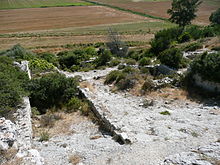- Janiculum
-
The Janiculum Hill,
a hill of RomeIn Latin / Italian Janiculum /
GianicoloRione Trastevere Buildings Academia de España in Rome, American Academy in Rome,
Acqua Paola, Water Mill (site)Churches San Pietro in Montorio, San Pancrazio Events 1849 battle Ancient Roman religion augurs Mythological figures Janus  The Janiculum Hill seen from NE. At lower left, the church of San Pietro in Montorio. At lower center, the Academia de España in Rome. At middle right, the Acqua Paola. At top center, the roof of the American Academy.
The Janiculum Hill seen from NE. At lower left, the church of San Pietro in Montorio. At lower center, the Academia de España in Rome. At middle right, the Acqua Paola. At top center, the roof of the American Academy.
The Janiculum (il Gianicolo in Italian) is a hill in western Rome, Italy. Although the second-tallest hill (the tallest being Monte Mario) in the contemporary city of Rome, the Janiculum does not figure among the proverbial Seven Hills of Rome, being west of the Tiber and outside the boundaries of the ancient city.
Contents
Sights
The Janiculum is one of the best locations in Rome for a breathtaking view of the innumerable domes and bell towers that pierce the skyline of the multi-hued architectural museum. Other sights on the Janiculum include the church of San Pietro in Montorio, built upon the site formerly thought to be where St Peter was crucified; the small shrine known as the Tempietto, designed by Donato Bramante, marks the supposed site of Peter's death. The Janiculum also houses a Baroque fountain built by Pope Paul V in the late-17th century, the Acqua Paola, and several foreign research institutions, including the American Academy in Rome and the Spanish Academy in Rome. The Hill is also the location of the American University of Rome, Pontifical Urban University, and Pontifical North American College, as well as the Orto Botanico dell'Università di Roma "La Sapienza" and the Palazzo Montorio, residence of the Ambassadors of Spain.
History
Ancient history and mythology
The Janiculum was a center for the cult of the god Janus, and the fact that it overlooked the city made it a good place for augurs to observe the auspices.
In Roman mythology, Janiculum is the name of an ancient town founded by the god Janus (the two-faced god of beginnings). In Book VIII of the Aeneid by Virgil (Publius Vergilius Maro), King Evander shows Aeneas (the Trojan hero of this epic poem) the ruins of Saturnia and Janiculum on the Capitoline hill near the Arcadian city of Pallanteum (the future site of Rome) (see line 473, Bk. 8). Vergil uses the presence of these ruins to stress the significance of the Capitoline hill as the religious center of Rome.
According to Livy, the Janiculum was incorporated into ancient Rome during the time of king Ancus Marcius in order that it not be occupied by an enemy. It was fortified by a wall and a bridge constructed across the Tiber to join it to the rest of the city.[1]
During the war between Rome and Clusium in 508 BC, it is said that the forces of Lars Porsena occupied the Janiculum and laid siege to Rome.[2]
The Water Mills
See also: List of Roman watermillsThe Aurelian Walls were carried up the hill to include the water mills used to grind grain towards providing bread flour for the city. The mill was, thus, it is presumed, built at the same time as or before the walls were built by the emperor Aurelian (reigned 270-275 AD). The mills were supplied from an aqueduct, where it plunged down a steep hill. Thus, the site resembles Barbegal, although excavations in the late 1990s suggest that they may have been undershot rather than overshot in design. The mills were in use in 537 AD when the Goths besieging the city cut off their water supply. However, they were subsequently restored and may have remained in operation until at least the time of Pope Gregory IV (827-44).[3]
19th century to present
The Janiculum is the site of a battle in 1849 between the forces of Garibaldi, defending the revolutionary Roman Republic and French forces fighting to restore the Temporal power of the Pope over Rome. Because of this battle, several monuments to Garibaldi and to the fallen in the wars of Italian independence are on the Janiculum, as well.
Daily at noon, a cannon fires once from the Janiculum in the direction of the Tiber to signal the exact time. This tradition goes back to December 1847, when the cannon of the Castel Sant'Angelo gave the sign to the surrounding belltowers to start ringing at midday. In 1904, the ritual was transferred to the Janiculum and continued until 1939. On 21 April 1959, popular appeal convinced the Commune of Rome to resume the tradition after a twenty-year interruption.
The hill is featured in the third section of Ottorino Respighi's famous orchestral piece The Pines of Rome.
See also
- Seven hills of Rome
- Aventine Hill (Aventino)
- Caelian Hill (Celio)
- Capitoline Hill (Capitolino)
- Cispian Hill (Cispio)
- Esquiline Hill (Esquilino)
- Monte Mario
- Oppian Hill (Oppio)
- Palatine Hill (Palatino)
- Pincian Hill (Pincio)
- Quirinal Hill (Quirinale)
- Vatican Hill (Vaticano)
- Velian Hill (Velia)
- Viminal Hill (Viminale)
- Mountain View High School
References
External links
 Media related to il Gianicolo (Rome) at Wikimedia Commons
Media related to il Gianicolo (Rome) at Wikimedia Commons- The Janiculum at Lacus Curtius
- Roman Bookshelf - The Pauline Fountain (Janiculum) - Views from XVIII and XIX Century
- Recent excavations of the mills
Coordinates: 41°53′30″N 12°27′40″E / 41.89167°N 12.46111°E
Categories:- Hills of Rome
Wikimedia Foundation. 2010.

